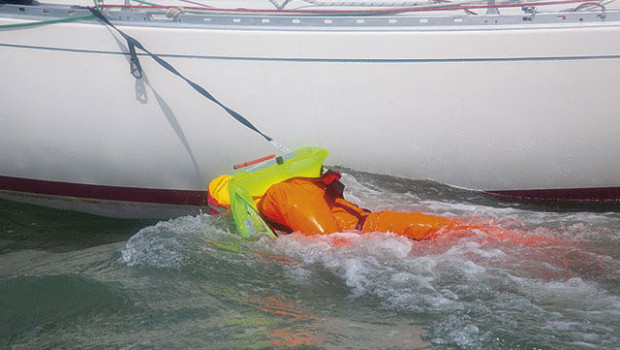Man Overboard: Is it safe to use a tether?
Published on December 16th, 2015
by Ben Meakins, Practical Boat Owner
Perceived wisdom is that if you fall overboard, staying tethered to the boat will keep you safe. But is that the case? PBO’s test team conduct some trials…with sobering results.
The tragic drowning of the skipper of the Reflex 38 Lion 15 miles south of Selsey Bill in 2011 shocked the sailing world. But the subsequent Marine Accident Investigation Branch (MAIB) report was truly chilling because it emerged that Mr Christopher Reddish (47) had done everything by the book. He was wearing a lifejacket and he was clipped on with a tether, or safety, line – but when he went overboard from the foredeck on a dark night he was dead by the time the crew could recover him.
The man overboard drill that crews generally practice, and which mirrors the Royal Yachting Association (RYA) syllabus, deals almost exclusively with recovering an untethered casualty from the water – mostly involving a fender floating free, retrieved with a stab from a boathook. The ability to return to a free-floating MOB and pick him up successfully is an important skill to have, but it doesn’t help us recover someone who is still attached the boat. As Christopher Reddish’s death proved, this could have tragic consequences.
Excerpt from the Lion MAIB report:
“At 0027 on 18 June 2011, the No1 genoa was being passed into the cockpit when it was noticed that the skipper had fallen over the port side near the bow. The skipper was still connected to the starboard jackline by his 1.8m-long tether. The mainsheet was immediately slackened and the foresail released, which slowed the yacht’s speed to 1.5 knots around 3 minutes after the skipper fell overboard.
The skipper was found in the water with his lifejacket inflated and the lifejacket bladder over his head, obscuring part of his face. His tether was still connected to the starboard jackline and had passed over the spinnaker pole and under the lower guardwire on the port side. The team managed to raise the skipper’s head above water, but there was no reaction from him. Attempts to clear the skipper’s airways and check for signs of life
proved very difficult because of the obstructing lifejacket bladder.
The recovery team fought hard to keep the skipper’s head above water… however, he repeatedly slipped under the surface. After 8-9 minutes of frustrated effort… they clipped the spinnaker halyard directly to the skipper’s tether. The skipper was lifted partially clear of the water and was grabbed as his lifejacket started to slip up his body.
It took the crew 16 minutes to recover the skipper to the deck, where he was pronounced dead by a consultant cardiologist who was one of the crew.”
Speed towing trials
To find out what it is like to lose and recover a tethered MOB, PBO’s test team headed into the Solent on a Sigma 38, Festina Lente, with a stiff 25-knot south-easterly breeze whipping up a big spring tide to a nasty chop. Our ‘casualty’ was Fred, a realistic, weighted rescue dummy wearing a lifejacket. Once in the water Fred would act in much the same way as an incapacitated sailor. First up, we wanted to see how the dummy coped with being towed through the water, so we motored at a series of fixed speeds. Here, he’s attached via a standard, long tether to the jackstay, passing under the guardwires.
Much more… full report.









 We’ll keep your information safe.
We’ll keep your information safe.